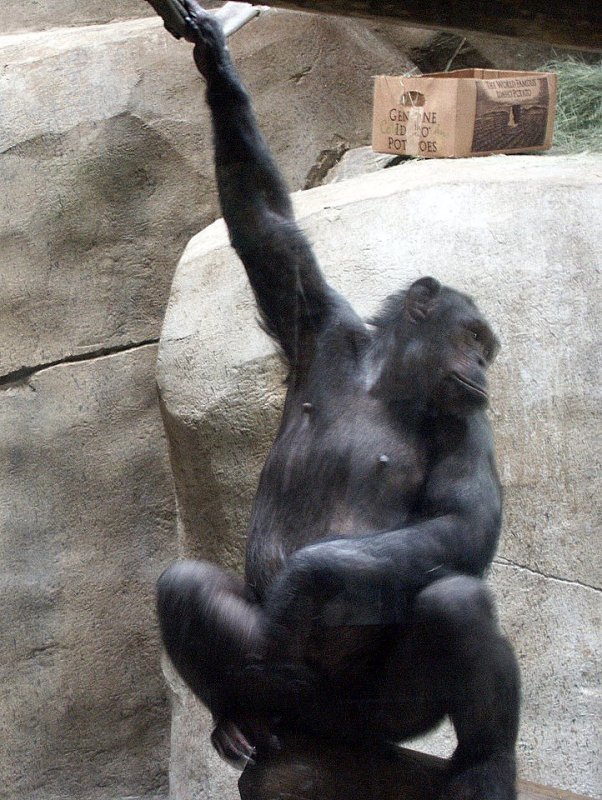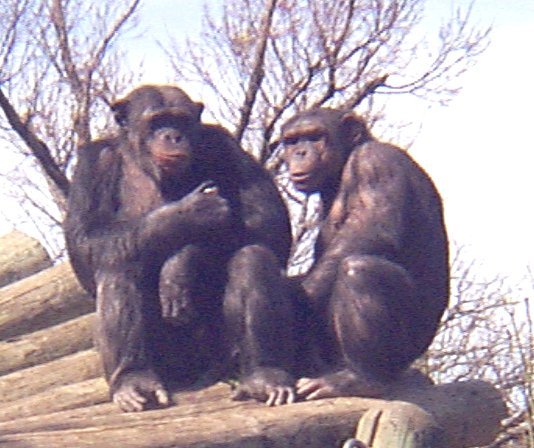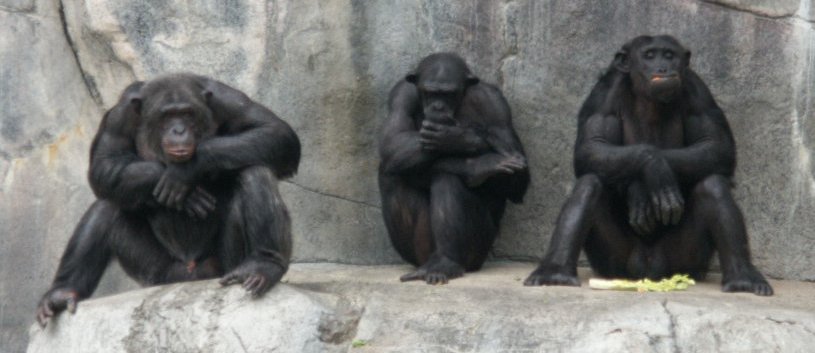|
Physical description:
Infant chimpanzees weigh about four pounds at birth. By adulthood
chimpanzees weigh approximately 95-150 pounds and are 3 to 4 feet tall.
A chimpanzee's body is covered with short thick,black hair.
General information:
 Chimpanzees
are very social animals." Chimpanzees as a whole usually live in large
groups of 30 to 80 chimpanzees: females, males and their offspring.
However, chimpanzees divide into smaller groups for hunting and foraging.
This allows them to cover more ground and be able to feed from the best
foraging locations (Monkeys and Apes p.26)."Separating into smaller
groups also decreases the ' constant ' dissension among competing male
chimpanzees "(Monkeys and Apes p.27). Chimpanzees
are very social animals." Chimpanzees as a whole usually live in large
groups of 30 to 80 chimpanzees: females, males and their offspring.
However, chimpanzees divide into smaller groups for hunting and foraging.
This allows them to cover more ground and be able to feed from the best
foraging locations (Monkeys and Apes p.26)."Separating into smaller
groups also decreases the ' constant ' dissension among competing male
chimpanzees "(Monkeys and Apes p.27).
"Female chimpanzees give birth to a single infant about every 3 to 5 years
so the arrival of a new chimpanzee is special and exciting for the other
chimps in the group "(Monkeys and Apes p.28). "Baby chimps weigh
only about 4 pounds at birth and are as about as helpless as human babies.
Female chimps give their baby lots of love and affection. This love and
affection can be seen when the mother chimp cradles and rocks her infant
to sleep. Even her breast feeding is second only to that of a human mother"
(Monkeys and Apes p.30).
 "Young
chimpanzees depend upon their mothers for years to teach them about their
world as a chimpanzee."(Monkeys and Apes p.31). "Growing up as a chimpanzee
involves long hours of play and learning in groups of 2 or 3 pre-adolescent
chimps. The males jump, wrestle, chase one another, and pull on each other's
tail. Interaction with older chimpanzee males usually involves a lot of
male competition games" (The Primates p.102). "Young
chimpanzees depend upon their mothers for years to teach them about their
world as a chimpanzee."(Monkeys and Apes p.31). "Growing up as a chimpanzee
involves long hours of play and learning in groups of 2 or 3 pre-adolescent
chimps. The males jump, wrestle, chase one another, and pull on each other's
tail. Interaction with older chimpanzee males usually involves a lot of
male competition games" (The Primates p.102).
"Chimpanzees learn to build nesst for sleeping
in at night.The youngest of the adolescent chimpanzees usually beds down
with mother until he is older. Nest sharing by older adolescent chimps
is
also common" (Primate Behavior p.385). "But not all chimpanzees prefer
to build their nest, some mischievous chimps prefer to steal a nest from
a wandering chimp" (Primate Behavior p.388).
 "Chimpanzees
must learn to share the rain forest with four species of monkeys: The
Blue Monkey, The Red tail Monkey, The Black and White Colobus Monkey and
the Olive Baboon. The first 3 of the species "Chimpanzees
must learn to share the rain forest with four species of monkeys: The
Blue Monkey, The Red tail Monkey, The Black and White Colobus Monkey and
the Olive Baboon. The first 3 of the species
freely mix with the others but not with the baboons or chimpanzees"
(Primate Behavior p.389).
" Chimpanzees are intelligent animals capable of
possessing a level of intelligence that enables them to learn from one
another.For example, some chimps fashion twigs to use as a tool for
extracting termites from their mounds." (The Primates p.153). A recent
news article suggests that early humans also took advantage of this food
source!
" Chimpanzees have artisttic ability as well.
Zoologist Desmond Morris discovered through his working with chimpanzees
that chimps paint much like human children paint.However, chimpanzees do
not paint art at random. Chimpanzees possess a definite and discernible
sense of form and even individual style"(The Primates p.155 ). This may
contribute to the close similarities of chimpanzees and humans.
 "
The chimpanzee is man's closest relative.There are fundamental similarities
that show the two, humans and chimpanzees, evolved from a common ancestrial
stock, although exactly when the two stocks separated is still hotly debated
" (Monkeys and Apes p.26 ). " The chimpanzee's black thick coat
has roughly the same number of hairs as a man's body, although each of
a chimp's hairs are longer, thicker and dark and much more conspicious
than man's. The chimpanzee's torso is virtually identical to man's except
in its proportions. Long arms and short legs give the chimp a lumbering
quadrupedal gait, similar to the gorilla and very different from man's
upright, striding walk"(Monkeys and Apes p.26). "
The chimpanzee is man's closest relative.There are fundamental similarities
that show the two, humans and chimpanzees, evolved from a common ancestrial
stock, although exactly when the two stocks separated is still hotly debated
" (Monkeys and Apes p.26 ). " The chimpanzee's black thick coat
has roughly the same number of hairs as a man's body, although each of
a chimp's hairs are longer, thicker and dark and much more conspicious
than man's. The chimpanzee's torso is virtually identical to man's except
in its proportions. Long arms and short legs give the chimp a lumbering
quadrupedal gait, similar to the gorilla and very different from man's
upright, striding walk"(Monkeys and Apes p.26).
The similarities don't end there. " The chimpanzee's
reproductive processes and a human's reproductive processes are also similar.
The menstrual cycle in a female chimpanzee lasts 35 days with a 10 day
sexual receptive factor. Human menstrual cycles are 28 days with a 7 day
receptive factor. At approximately age 13 a female chimpanzee is considered
a young adult, about the same time as a female human begins transforming
into womanhood"(Monkeys and Apes p.27). |


![]()